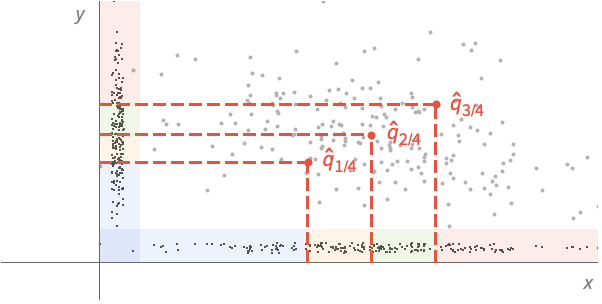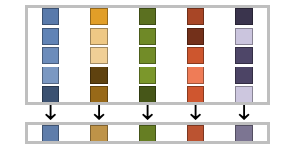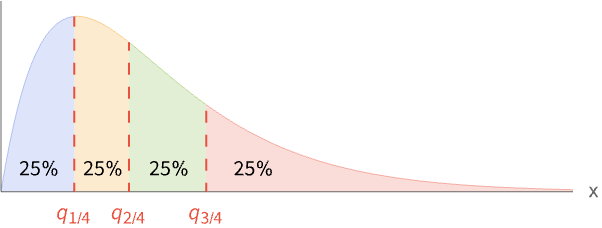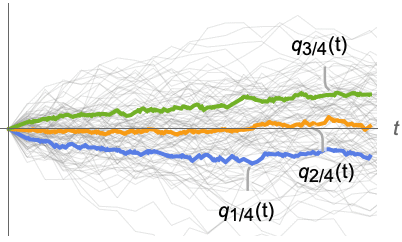Quartiles
Quartiles[data]
gives the ![]() quantile estimates of the elements in data.
quantile estimates of the elements in data.
Quartiles[data,{{a,b},{c,d}}]
uses the quantile definition specified by parameters a, b, c, d.
Quartiles[dist]
gives the ![]() quantiles of the distribution dist.
quantiles of the distribution dist.
Details




 is equivalent to the median. »
is equivalent to the median. » is equivalent to the average of the medians of the
is equivalent to the average of the medians of the  and
and  smallest elements in data if
smallest elements in data if  is odd, and the median of the
is odd, and the median of the  smallest elements if
smallest elements if  is even.
is even. is defined like
is defined like  , but with the largest rather than smallest elements.
, but with the largest rather than smallest elements.- For MatrixQ data, the quartile is computed for each column vector with Quartiles[{{x1,y1,…},{x2,y2,…},…}] equivalent to {Quartiles[{x1,x2,…}],Quartiles[{y1,y2,…}]}. »
- For ArrayQ data, quartiles are equivalent to ArrayReduce[Quartiles,data,1]. »
- Quartiles[data] is equivalent to Quantile[data,{1,2,3}/4,{{1/2,0},{0,1}}]. »
- Quartiles[data,{{a,b},{c,d}}] is equivalent to Quantile[data,{1,2,3}/4,{{a,b},{c,d}}].
- Common choices of parameters {{a,b},{c,d}} include:
-
{{0,0},{1,0}} inverse empirical CDF {{0,0},{0,1}} linear interpolation (California method) {{1/2,0},{0,0}} element numbered closest to p n {{1/2,0},{0,1}} linear interpolation (hydrologist method; default) {{0,1},{0,1}} mean‐based estimate (Weibull method) {{1,-1},{0,1}} mode‐based estimate {{1/3,1/3},{0,1}} median‐based estimate {{3/8,1/4},{0,1}} normal distribution estimate - The default choice of parameters is {{1/2,0},{0,1}}. »
- The data can have the following additional forms and interpretations:
-
Association the values (the keys are ignored) » SparseArray as an array, equivalent to Normal[data] » QuantityArray quantities as an array » WeightedData based on the underlying EmpiricalDistribution » EventData based on the underlying SurvivalDistribution » TimeSeries, TemporalData, … vector or array of values (the time stamps ignored) » Image,Image3D RGB channel's values or grayscale intensity value » Audio amplitude values of all channels » - Quartiles[dist] gives the list
 corresponding to Quantile[dist]. »
corresponding to Quantile[dist]. » - For a random process proc, the quartiles function can be computed for slice distribution at time t, SliceDistribution[proc,t], as Quartiles[SliceDistribution[proc,t]]. »





Examples
open allclose allScope (18)
Basic Uses (8)
Exact input yields exact output:
Approximate input yields approximate output:
Compute results using other parametrizations:
Find the quartiles of WeightedData:
Find the quartiles of EventData:
Find the quartiles of TemporalData:
Find the quartiles of TimeSeries:
Array Data (5)
Quartiles for a matrix gives columnwise quartiles:
Quartiles for a tensor gives columnwise medians at the first level:
When the input is an Association, Quartiles works on its values:
SparseArray data can be used just like dense arrays:
Find quartiles of a QuantityArray:
Image and Audio Data (2)
Applications (4)
Quartiles divide a distribution in four equal probability sections:
Find a moving quartile envelope for a time series:
Data smoothed by moving median:
Moving envelope of first and third quartiles:
Find the quartiles for data representing the top oil-producing fields in 2001:
Compare with the minimum and maximum values for the data:
Plot the data with quartile lines:
Compute the quartiles for the heights of children in a class:
Properties & Relations (6)
Quartiles are given by linearly interpolated Quantile values:
The default parameters for Quantile give a different result:
The second quartile of the data is the Median:
The quantile of 1/2 does not average the two middle elements for lists of even length:
InterquartileRange is the difference between the first and third quartiles:
QuartileDeviation is half the difference between the first and third quartiles:
QuartileSkewness is a skewness measure obtained from the quartiles:
BoxWhiskerChart shows the quartiles for data:
Text
Wolfram Research (2007), Quartiles, Wolfram Language function, https://reference.wolfram.com/language/ref/Quartiles.html (updated 2023).
CMS
Wolfram Language. 2007. "Quartiles." Wolfram Language & System Documentation Center. Wolfram Research. Last Modified 2023. https://reference.wolfram.com/language/ref/Quartiles.html.
APA
Wolfram Language. (2007). Quartiles. Wolfram Language & System Documentation Center. Retrieved from https://reference.wolfram.com/language/ref/Quartiles.html